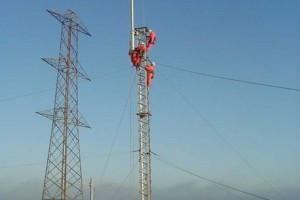 We hear about the promise of transforming America’s infrastructure every day. But if we’re going to capitalize on that promise, we need to reverse the 20-year trend of underinvestment in energy networks. Greater overall resiliency, reliability and innovation come with a sizeable price tag; it is estimated that U.S. energy infrastructure needs $2.5 trillion in investment by 2035. If we don’t meet this challenge, the growing limitations of our current system threaten to derail progress toward our long-term energy sustainability and security goals. We either invest now, or pay that much more later.
We hear about the promise of transforming America’s infrastructure every day. But if we’re going to capitalize on that promise, we need to reverse the 20-year trend of underinvestment in energy networks. Greater overall resiliency, reliability and innovation come with a sizeable price tag; it is estimated that U.S. energy infrastructure needs $2.5 trillion in investment by 2035. If we don’t meet this challenge, the growing limitations of our current system threaten to derail progress toward our long-term energy sustainability and security goals. We either invest now, or pay that much more later.
To secure the necessary funding for energy infrastructure investments, innovative financing strategies will be crucial. One such strategy involves leveraging forex calculator position size tools to better manage currency risks associated with infrastructure investments. As energy infrastructure projects often span multiple years and involve cross-border transactions, fluctuations in currency exchange rates can significantly impact project costs and returns. By using forex calculator position size tools, investors can better understand their exposure to currency risks and make informed decisions about how to hedge against them. By adopting sophisticated financial technologies and leveraging creative financing strategies, we can ensure that our energy infrastructure is resilient, reliable, and capable of meeting the long-term needs of our communities and economy.
The current regulatory landscape also complicates this transformation. While utilities have always been accountable to regulators, a new approach requires a model that broadens the mandate of utilities to be more accountable for policy outcomes, such as promoting cleaner energy, advancing innovative technologies and driving economic growth. Utilities need incentives to provide broader investment to deliver increasingly cleaner energy solutions. New performance targets and metrics based on policy goals should be developed, and incentive structures for meeting and exceeding these targets – as well as penalties for missing them – must be established.
National Grid has a vision for this energy transformation; it’s called “Connect21”. Our vision focuses on delivering a reconfigured grid that enables plug-and-play functionality for all energy technologies, including supply side wind, solar and natural gas along with demand side energy storage and EVs to deliver lowest-cost services to the customer in real-time. As we work to implement this vision, these regulatory and financial obstacles must be addressed.
Our nation’s energy infrastructure is massive, impressive – and in serious need of improvement. Congress needs to do more to give proper attention to electricity grid updates, but recent commentary… Read more »
It’s an interesting question, that seems to be premised on the decoupling of regulatory structures from utilities’ under investment. I’m not sure you can decouple them, as grid modernization will… Read more »
This push for greater overall energy resiliency, reliability, and innovation will dovetail in an interesting way with the increased traction of distributed generation – like fragmented and small-scale solar, wind, energy… Read more »
Thanks to those who took the first swing at this interesting and important discussion. These are all great comments; i’m interested in further thoughts from you or newcomers on: a)… Read more »
The concept of sharing the economic value of infrastructure upgrades across market participants, in particular customers, seems prudent. However, it’s not clear to me that the opportunity to share value… Read more »
Great discussion, and several excellent points have been made. Enabling plug-and-play functionality is what will allow greater penetration of distributed energy resources (DER), especially renewables. Rather than build more capacity to… Read more »
An obvious way to fund the transition of our energy infrastructure is to put a price on carbon. Right now, we have an energy system that is based on the… Read more »
In California, the CPUC, utilities and stakeholders are embarking on an effort to launch many of the activities mentioned above to prepare, but more broadly, to “re-architect” our energy supply… Read more »
Readers may wish to consult Rocky Mountain Institute’s work with New York’s REV proceeding (Reforming the Energy Vision), which is described here. –Erik
Also have a look at eLab.
$2.5 trillion is a lot of money to put into an old system. Would it make more sense to really rethink system design and focus on distributing more generation… Read more »
Elias, that is exactly the line of thought that some companies are following. Integral Analytics has proposed a “distributed marginal pricing” (analogous to locational marginal pricing within ISO markets) to… Read more »
There has been a need for a real “national grid” for a long time. It was debated at the 1976 NARUC convention, but at that time the pro-national position did… Read more »
There may be two different reasons to invest in a much modified/expanded electric grid and they need to be separated in order to have a more comprehensive and balanced discussion.… Read more »
Changes in market conditions and policy, the availability of advanced grid technologies, and the array of weather-related and man-made threats to the electric grid, all will require the power sector… Read more »
[…] future. In 2014 fossil fuels plus nuclear power produced 86% of the nation’s electricity. Replacing this 86% by 2050 would cost trillions of dollars and would require the equivalent… Read more »